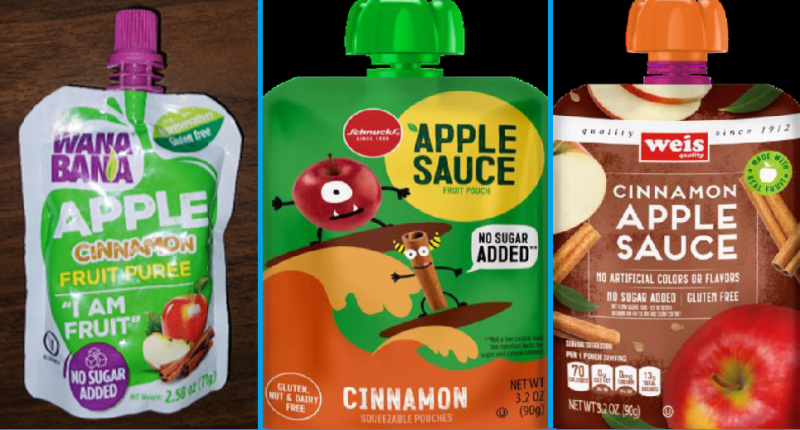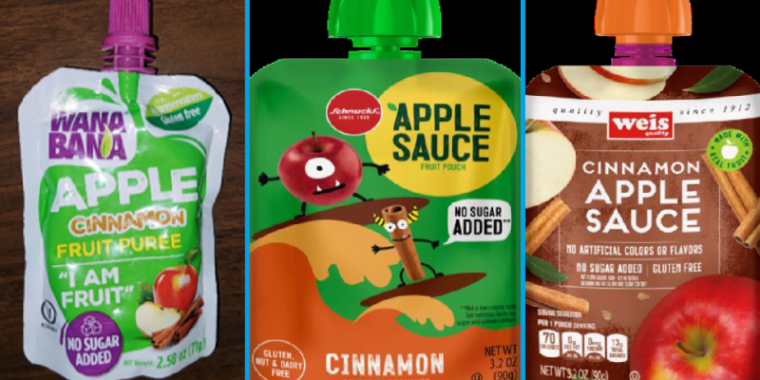Chromium found in lead-tainted fruit pouches may explain contamination
Nightmare —
Lead chromate, an artificial coloring, has been used in other spices to conceal poor quality.

Enlarge / The three recalled pouches linked to lead poisonings.
The Food and Drug Administration has discovered a second metal contaminant—chromium—in the recalled cinnamon applesauce pouches found to contain cinnamon contaminated with extremely high levels of lead. The products have now poisoned nearly 300 young children in 37 states.
The health implications of the additional contaminant are not clear. There is no antidote for chromium exposure, and the Centers for Disease Control and Prevention recommends supportive care. But the finding does hint at the possible motivation behind the tragic poisonings.
In the FDA’s announcement, the agency noted that “The lead-to-chromium ratio in the cinnamon apple puree sample is consistent with that of lead chromate (PbCrO4).” This is a notorious adulterant of spices used to artificially bolster their color and weight.
Lead chromate is a vibrant yellow substance that has frequently turned up in turmeric sourced from India and Bangladesh. In a 2017 study by public health researchers at Boston University, 16 of 32 turmeric products bought in markets in the Boston area had lead levels over the FDA’s allowable lead level for candy (the FDA does not have guidelines for lead levels in spices, specifically). Two samples, the only two samples sourced from Bangladesh, exceeded the allowable lead level by two orders of magnitude. The researchers had conducted the study after a string of lead poisoning cases in US children were linked to contaminated spices, including turmeric. Other studies have also identified spices as a source of lead exposure in US children.
The 2017 study highlighted the reason that lead chromate is used as an adulterant. A media outlet in Bangladesh quoted one turmeric trader’s explanation: “Traders use the artificial color [lead chromate] to hide the marks of pest attacks and other spots on raw turmeric. It is used during boiling and polishing to make the spice look brighter to attract big buyers, including spice processing firms.”
The FDA’s testing does not definitively conclude that lead chromate was in the contaminated cinnamon, which was sourced from an Austrofoods manufacturing facility in Ecuador and used in the recalled applesauce pouches. But it does bolster the FDA’s suspicion that the poisonings were the result of “economically motivated adulteration,” a specific category of food fraud defined by the FDA.
Jim Jones, FDA’s deputy commissioner for human foods, told Politico in December that the agency believed then that the contamination was economically motivated. “My instinct is they didn’t think this product was going to end up in a country with a robust regulatory process,” Jones said. “They thought it was going to end up in places that did not have the ability to detect something like this.”
Health effects
For the hundreds of US children poisoned by the applesauce pouches, the finding of chromium adds yet more nightmarish uncertainty of possible long-term health effects. Lead is a potent neurotoxic metal that can damage the brain and nervous system. In developing toddlers and younger children, the effects of the acute exposures could manifest as learning and behavior problems, as well as hearing and speech problems in the years to come.
The effects of chromium exposure are less clear. Chromium is a naturally occurring metal and an essential trace nutrient. But there are two notable forms: chromium III and the more toxic chromium VI. The FDA’s testing couldn’t identify which form of chromium was present in the cinnamon applesauce pouches, but the more toxic chromium VI is what’s present in lead chromate. Chromium VI is considered a carcinogen, and chronic, prolonged inhalation and skin exposure is associated with chronic lung disease and ulceration of skin and mucous membranes, the CDC notes. But the effects of eating chromium VI are not well studied or understood beyond the immediate, nonspecific effects of an acute exposure—which might include abdominal pain, nausea, vomiting, diarrhea, anemia, and kidney and liver dysfunction.
The CDC and the FDA note that it’s possible that even if chromium VI contaminated the applesauce pouches, the acidity of the applesauce and the stomach may have converted the chromium VI to chromium III.
The FDA recommends that the families of children exposed to the recalled pouches—especially those with elevated blood lead levels—should inform their health care providers of potential chromium exposure. The CDC provided clinical guidance for doctors on how to test and care for children with exposure.
The recalled cinnamon applesauce pouches include WanaBana apple cinnamon fruit puree pouches (sold nationally and through multiple retailers, including Amazon and Dollar Tree), Schnucks-brand cinnamon-flavored applesauce pouches and variety packs (sold at Schnucks and Eatwell Markets grocery stores), and Weis-brand cinnamon applesauce pouches (sold at Weis grocery stores).
According to the CDC’s latest numbers, which, as of the time of publication, were last updated on December 29, there have been a total of 287 cases identified across 37 states.
Chromium found in lead-tainted fruit pouches may explain contamination Read More »
